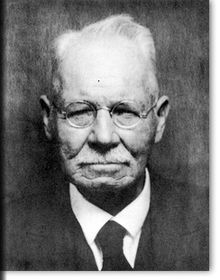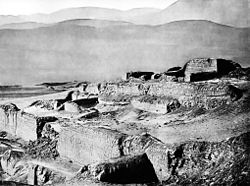Max Uhle
Friedrich Max Uhle (born March 25, 1856 in Dresden ; † May 11, 1944 in Loben ) is considered the "father of archeology in South America " and "founder of Andean archeology ", as he has carried out numerous excavations in more than 40 years of his research life in South America in Argentina , Peru , Chile , Ecuador and Bolivia a large number of archaeological finds were found which he analyzed scientifically and museologically.
Uhle was trained first as a philologist and linguist, then as an ancient Americanist and as such made significant contributions to the knowledge of the chronology and cultures of pre-Hispanic and pre-Inca peoples in western South America. He was one of the most important German Old Americanists .
As a linguist and museum ethnologist in Dresden and Berlin
Max Uhle was born in Dresden in 1856 as the son of a respected surgeon and royal Saxon chief medical officer and his wife . He passed his Abitur in St. Afra in Meißen in 1875 and studied philology and general linguistics at the universities of Leipzig (1875 and 1877-1880) and Göttingen (1876/77). He put his focus on oriental and East Asian languages. He received his doctorate in 1880 under Hans Georg Conon von der Gabelentz on pre-classical Chinese texts.
From 1881 to 1888 he worked at the Royal Zoological and Anthropological-Ethnographic Museum in Dresden as a museum ethnologist. He mainly dealt with ethnographic and archaeological objects from distant cultural regions, including Americana. In the course of his work, he met the private scholar and explorer Alfons Stübel , who had returned from South America in 1882 and who had donated part of his collection to the Ethnological Museum.
In 1888 he moved to the Museum of Ethnology in Berlin , which under its founder Adolf Bastian became a center of German American studies . During this time, Uhle became an expert on pre-Columbian cultures on the west coast of South America. He was particularly interested in the cultural connections and, at the time, quite uncertain chronological sequences of cultures.
He was in correspondence with the sinologist Wilhelm Grube .
Research in South America
Starting in 1891, at the suggestion of Stübel, he planned a research trip that was originally supposed to last from 1892 to 1895, but Uhle stayed in South America for 41 years - with a few interruptions. He explored the north of Argentina in 1892 and 1893 , reached La Paz in Bolivia in 1894 , where a financial bottleneck prevented further travel. Uhle used the time to study the Aymara language linguistically . Appalled by the state of the Tiahuanaco monuments , he wrote a letter to the Bolivian government calling on them to be more resolute in protecting them.

Finally, he was able to continue his journey after a change in sponsorship to the University of Pennsylvania had succeeded with the help of Bastian and the Americanist Zelia Nuttall . In January 1896, Uhle reached Lima , Peru . After a few excursions, in March he began digging in Pachacámac , a pre-Hispanic pilgrimage site 30 km south of Lima. Due to the various layers of the excavation, he was able to provide evidence of a pre-Columbian cultural sequence, which ended with the Inca culture.
Subsequently, Uhle stayed for some time in Philadelphia , where he documented his excavations in a monograph published in 1903, gave lectures and married his translator, Charlotte Grosse, who was of German origin. In 1902 he also carried out excavations on the San Francisco Bay and was the first to apply the stratigraphic method in the USA when he excavated and documented Shell middens .
Since 1904, financed by the University of California at Berkeley , he was able to undertake another research trip to Trujillo in Peru, which was supposed to serve nominally to expand the holdings of the anthropological museum in Berkeley, which was currently being built. In 1905 this contract was not extended, probably also because new Peruvian regulations made the export of archaeological finds more difficult.
Uhle was now head of the archaeological department of the Museo Nacional de Historia in Lima. He mainly explored the southern Sierra of Peru. Since 1909 increasing financial problems and intrigues made him move to Santiago de Chile in 1912 , where he built the Museo de Etnología y Antropología. In addition to the museum work, he researched the antiquities, especially of the Chilean north.
He intensified these excavations during temporary unemployment before he was invited to Ecuador in 1919 by the Ecuadorian historian, politician and archaeologist Jacinto Jijón y Caamaño . After Jijón y Caamaño terminated his contract with Uhle in 1924 due to personal political problems, the Ecuadorian government set up a chair for Ecuadorian archeology at the Universidad Central in Quito , which Uhle had held since 1925. Here, too, he set up an archaeological museum and undertook numerous excavations.
Among other things, Uhle discovered the remains of the Inca Tumipampa in Cuenca and researched pre-Columbian cultures on the Pacific coast and the Ecuadorian Sierra. In his academic work and lectures, he emphasizes the influences from Central America on the Pre-Inca cultures in Ecuador and deepened the model of South American cultural development that was outlined in the 1890s.
Return to Germany
When Uhle returned to Germany in 1933, now at the age of 77, he was largely impoverished. He got a job at the recently founded Ibero-American Institute and gave university lectures. In 1935 and 1936 he was honored several times. In 1935 and 1939 he traveled to Americanist congresses in Seville and Lima. Due to the Second World War , he was only able to return to Berlin from Lima in 1942. Because of the bombing raids, Uhle moved first to Saxony and then to Silesia , where he died in May 1944 in a sanatorium in Loben . The Uhles estate is in the Ibero-American Institute of Prussian Cultural Heritage in Berlin .
Honors and memberships
- The German school in Arequipa in Peru is called "Max Uhle".
- The Museo Regional de Casma Max Uhle in Casma (Peru), which opened in 1984, is named after him.
- Uhle was a member of the Berlin Society for Anthropology, Ethnology and Prehistory .
Fonts
- Pachacamac . University Museum of Archeology and Anthropology, University of Pennsylvania, Philadelphia 1903.
- Los orígenes de los incas . Coni Hermanos, Buenos Aires 1912.
- The ruins of Moche . In: Journal de la société des américanistes de Paris. Volume 10, 1913, pp. 95–117.
- The Nazca pottery of ancient Peru . Davenport Academy of Sciences, Davenport 1914.
- The ancient cultures of Peru in terms of the archeology and history of the American continent . Süsserott, Berlin-Wilmersdorf 1935.
- About the condor and the fox. Shepherd's tale from the mountains of Peru / Quechua and German . Transferred and edited by Antje Kelm. Gebr. Mann, Berlin 1968.
- Plans of archaeological sites in the Andean region / Planos de sitios arqueológicos en el área andina (= materials for general and comparative archeology. Volume 56). Edited by Wolfgang W. Wurster . von Zabern, Mainz 1999, ISBN 3-8053-2612-2 .
literature
in order of appearance
- El Jubileo del prof. Max Uhle. Su bibliografia . Lima 1935 (reprint from the Revista del Museo Nacional de Lima , vol. 4 (1935), issue 1).
- John Howland Rowe : Max Uhle, 1856-1944. A memoir of the father of Peruvian archeology . University of California Press, Berkeley 1954.
- Eloy Linares Malaga: El anthropologo aleman Friedrich Max Uhle. "Padre de la arqueología Andina" . Lima 1964.
- Peter Kaulicke (Ed.): Max Uhle y el Perú antiguo . Fondo Editorial de la Pontificia Universidad Católica del Perú, Lima 1998, ISBN 9972-42-139-2 .
- Carmen Beatriz Loza: Itinerarios de Max Uhle en el altiplano boliviano. Sus libretas de expedición e historias cultural (1893-1896) . Gebr. Mann Verlag, Berlin 2004, ISBN 3-7861-2444-2 .
- Peter Kaulicke (Ed.): Max Uhle (1856–1944). Evaluaciones de sus investigaciones y obras . Fondo Editorial de la Pontificia Universidad Católica del Perú, Lima 2010, ISBN 978-9972-42-929-3 .
- Michael Höflein: Life and Work of Max Uhles. A bibliography (= Ibero Bibliographies, Vol. 1). Ibero-American Institute of Prussian Cultural Heritage, Berlin 2001.
- Daniela Mihok: Sideways glances from Max Uhle's photographs from Peru . Metropol, Berlin 2012, ISBN 978-3-86331-113-1 .
Web links
- Max Uhles estate in the Ibero-American Institute of the Prussian Cultural Heritage Foundation , therein as a PDF document: Michael Höflein: Life and Work of Max Uhles. A bibliography , Berlin 2002 (PDF; 573 kB).
- Picture show about Max Uhle ( Memento from July 23, 2003 in the Internet Archive ) in the Netzeitung .
- Presentation page of the book Max Uhle y el Perú antiguo edited by Peter Kaulicke (Lima: Fondo Editorial de la Pontifícia Universidad Católica del Perú, 1998).
- Literature by and about Max Uhle in the catalog of the German National Library
- Works by and about Max Uhle in the German Digital Library
- Newspaper article about Max Uhle in the 20th century press kit of the ZBW - Leibniz Information Center for Economics .
- Literature on the Emeryville Shellmound excavation, pioneered by Max Uhle .
Individual evidence
- ↑ Wolfgang Haberland: American Archeology . Wissenschaftliche Buchgesellschaft, Darmstadt 1991, ISBN 3-534-07839-X , p. 18.
- ^ Teodoro Hampe Martínez: Max Uhle y los orígenes del Museo de Historia Nacional (Lima, 1906–1911) . In: Indiana. Volume 15, 1998, pp. 139–165, here pp. 143–148.
| personal data | |
|---|---|
| SURNAME | Uhle, Max |
| ALTERNATIVE NAMES | Uhle, Friedrich Max (full name) |
| BRIEF DESCRIPTION | German archaeologist |
| DATE OF BIRTH | March 25, 1856 |
| PLACE OF BIRTH | Dresden |
| DATE OF DEATH | May 11, 1944 |
| Place of death | Praise |

